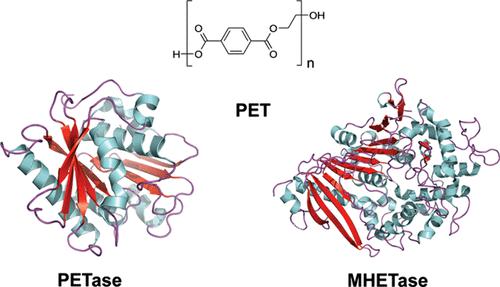当前位置:
X-MOL 学术
›
Biochemistry
›
论文详情
Our official English website, www.x-mol.net, welcomes your feedback! (Note: you will need to create a separate account there.)
Development of Enzyme-Based Approaches for Recycling PET on an Industrial Scale
Biochemistry ( IF 2.9 ) Pub Date : 2024-01-29 , DOI: 10.1021/acs.biochem.3c00554 Kohei Oda 1 , Alexander Wlodawer 2
Biochemistry ( IF 2.9 ) Pub Date : 2024-01-29 , DOI: 10.1021/acs.biochem.3c00554 Kohei Oda 1 , Alexander Wlodawer 2
Affiliation

|
Pollution by plastics such as polyethylene (PE), polypropylene (PP), polyvinyl chloride (PVC), polyurethane (PUR), polyamide (PA), polystyrene (PS), and poly(ethylene terephthalate) (PET) is now gaining worldwide attention as a critical environmental issue, closely linked to climate change. Among them, PET is particularly prone to hydrolysis, breaking down into its constituents, ethylene glycol (EG) and terephthalate (TPA). Biorecycling or bioupcycling stands out as one of the most promising methods for addressing PET pollution. For dealing with pollution by the macrosize PET, a French company Carbios has developed a pilot-scale plant for biorecycling waste PET beverage bottles into new bottles using derivatives of thermophilic leaf compost cutinase (LCC). However, this system still provides significant challenges in its practical implementation. For the micro- or nanosize PET pollution that poses significant human health risks, including cancer, no industrial-scale approach has been established so far, despite the need to develop such technologies. In this Perspective, we explore the enhancement of the low activity and thermostability of the enzyme PETase to match that of LCC, along with the potential application of microbes and enzymes for the treatment of waste PET as microplastics. Additionally, we discuss the shortcomings of the current biorecycling protocols from a life cycle assessment perspective, covering aspects such as the diversity of PET-hydrolyzing enzymes in nature, the catalytic mechanism for crystallized PET, and more. We also provide an overview of the Ideonella sakaiensis system, highlighting its ability to operate and grow at moderate temperatures, in contrast to high-temperature processes.
中文翻译:

开发基于酶的工业规模回收 PET 方法
聚乙烯(PE)、聚丙烯(PP)、聚氯乙烯(PVC)、聚氨酯(PUR)、聚酰胺(PA)、聚苯乙烯(PS)和聚对苯二甲酸乙二醇酯(PET)等塑料污染现已引起全世界的关注作为一个与气候变化密切相关的关键环境问题。其中,PET 特别容易水解,分解成其成分:乙二醇 (EG) 和对苯二甲酸酯 (TPA)。生物回收或生物升级回收是解决 PET 污染最有前途的方法之一。为了解决大尺寸 PET 造成的污染,法国 Carbios 公司开发了一个中试规模的工厂,利用嗜热叶堆肥角质酶 (LCC) 衍生物将废弃 PET 饮料瓶生物回收成新瓶子。然而,该系统在实际实施中仍然面临重大挑战。对于对人类健康构成重大风险(包括癌症)的微米或纳米级 PET 污染,尽管需要开发此类技术,但迄今为止尚未建立工业规模的方法。在本视角中,我们探索增强 PETase 酶的低活性和热稳定性以匹配 LCC,以及微生物和酶在将废 PET 处理为微塑料方面的潜在应用。此外,我们从生命周期评估的角度讨论了当前生物回收方案的缺点,涵盖自然界中PET水解酶的多样性、结晶PET的催化机制等方面。我们还概述了Ideonella sakaiensis系统,强调其在中等温度下(与高温过程相比)运行和生长的能力。
更新日期:2024-01-29
中文翻译:

开发基于酶的工业规模回收 PET 方法
聚乙烯(PE)、聚丙烯(PP)、聚氯乙烯(PVC)、聚氨酯(PUR)、聚酰胺(PA)、聚苯乙烯(PS)和聚对苯二甲酸乙二醇酯(PET)等塑料污染现已引起全世界的关注作为一个与气候变化密切相关的关键环境问题。其中,PET 特别容易水解,分解成其成分:乙二醇 (EG) 和对苯二甲酸酯 (TPA)。生物回收或生物升级回收是解决 PET 污染最有前途的方法之一。为了解决大尺寸 PET 造成的污染,法国 Carbios 公司开发了一个中试规模的工厂,利用嗜热叶堆肥角质酶 (LCC) 衍生物将废弃 PET 饮料瓶生物回收成新瓶子。然而,该系统在实际实施中仍然面临重大挑战。对于对人类健康构成重大风险(包括癌症)的微米或纳米级 PET 污染,尽管需要开发此类技术,但迄今为止尚未建立工业规模的方法。在本视角中,我们探索增强 PETase 酶的低活性和热稳定性以匹配 LCC,以及微生物和酶在将废 PET 处理为微塑料方面的潜在应用。此外,我们从生命周期评估的角度讨论了当前生物回收方案的缺点,涵盖自然界中PET水解酶的多样性、结晶PET的催化机制等方面。我们还概述了Ideonella sakaiensis系统,强调其在中等温度下(与高温过程相比)运行和生长的能力。



























 京公网安备 11010802027423号
京公网安备 11010802027423号